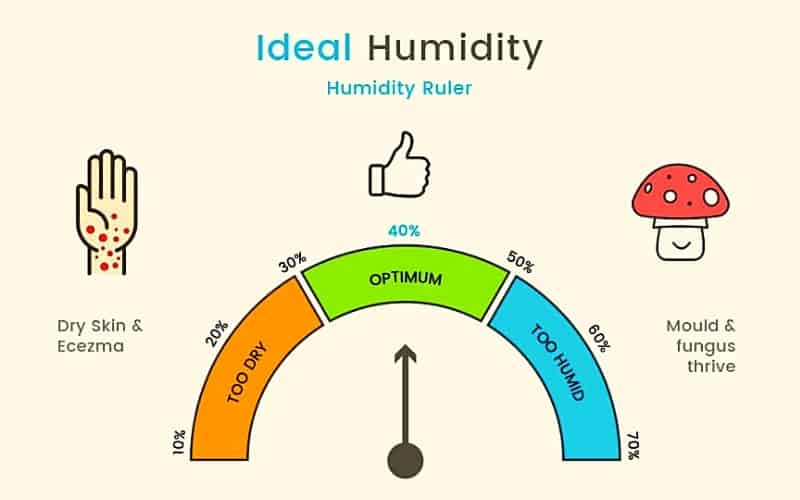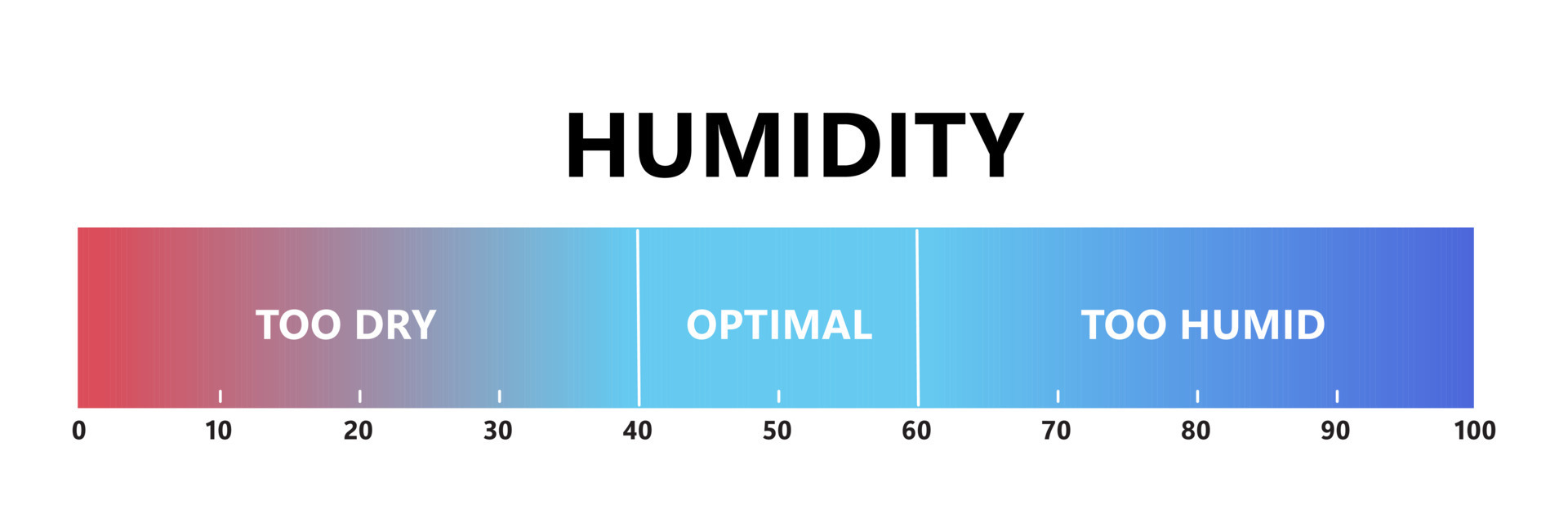What Is Considered A High Humidity Level
.jpg?width=3508&name=Humidity level chart (1).jpg)
Understanding Humidity: A Comprehensive Guide for Homeowners, Technicians, and Facility Managers
Humidity, the amount of water vapor present in the air, plays a critical role in our comfort, health, and the longevity of our buildings. While some humidity is necessary, excessively high levels can lead to a host of problems. This article will delve into what constitutes a "high" humidity level, its implications, and strategies for managing it, catering to homeowners, HVAC technicians, and facility managers alike.
Defining High Humidity
Relative humidity (RH) is the most common metric for measuring humidity. It represents the percentage of water vapor in the air compared to the maximum amount the air can hold at a specific temperature. A reading of 100% RH indicates that the air is saturated, and condensation will occur.
So, what's considered a high humidity level? Generally:
* Above 60% RH is considered high. This is where most people start to feel uncomfortable and the risk of mold growth increases. * Above 70% RH is definitely too high. At this level, you'll likely experience noticeable discomfort, and the potential for mold and mildew growth becomes significant. * Above 80% RH is critically high. Immediate action is needed to reduce humidity levels and prevent damage.It's important to remember that these are general guidelines. The ideal humidity level depends on factors like the season and personal preferences. For instance, slightly lower humidity levels are generally preferred during winter months.
The Problems Associated with High Humidity
High humidity isn't just uncomfortable; it can cause a range of problems:
* Health Issues: High humidity promotes the growth of mold, mildew, and dust mites, all of which are common allergens. This can exacerbate respiratory problems like asthma and allergies. It can also lead to heat stroke or heat exhaustion by preventing sweat from evaporating effectively, thus reducing the body's natural cooling mechanism. * Property Damage: Excess moisture can damage building materials like wood, drywall, and insulation. It can lead to rot, warping, and structural problems. Condensation can also stain walls, ceilings, and floors. * Increased Pest Activity: Many pests, including insects and rodents, thrive in humid environments. * Energy Inefficiency: High humidity makes it harder for your air conditioner to cool your home. The system has to work harder to remove moisture, leading to higher energy bills. * Uncomfortable Living Conditions: Sticky, clammy skin, musty odors, and general discomfort are common symptoms of high humidity.Recognizing the Signs of High Humidity
You don't always need a hygrometer (humidity meter) to detect high humidity. Look for these telltale signs:
* Visible Condensation: Condensation on windows, mirrors, and cold surfaces is a clear indicator. * Musty Odors: A lingering musty smell, especially in basements, bathrooms, and closets, is a sign of mold or mildew growth. * Water Stains: Water stains on walls, ceilings, or floors indicate moisture problems. * Warped Wood: Warped or buckled wood flooring or trim suggests excessive moisture. * Visible Mold or Mildew: Black, green, or white spots on surfaces are a sign of mold or mildew growth. * Sticky or Clammy Skin: A general feeling of stickiness or clamminess, even when not physically active.Strategies for Managing High Humidity
Fortunately, there are several effective strategies for managing high humidity, depending on the severity of the problem and the specific needs of your home or building.
* Ventilation: Proper ventilation is crucial. Use exhaust fans in bathrooms and kitchens to remove moisture generated during showering, cooking, and dishwashing. Ensure that your attic and crawl spaces are adequately ventilated. * Dehumidifiers: Portable dehumidifiers are effective for removing moisture from individual rooms. Consider a whole-house dehumidifier for more comprehensive humidity control. Whole-house dehumidifiers can be integrated with your HVAC system to automatically maintain optimal humidity levels throughout your home. They are generally more energy-efficient than multiple portable units. * Air Conditioners: Air conditioners remove moisture as they cool the air. Ensure that your air conditioner is properly sized for your home or building. An oversized unit may cool the air too quickly without adequately removing moisture. * Sealing Air Leaks: Sealing air leaks around windows, doors, and other openings can prevent humid air from entering your home. * Proper Drainage: Ensure that your gutters and downspouts are functioning correctly to divert water away from your foundation. Grading the soil around your home to slope away from the foundation can also help prevent moisture intrusion. * Professional HVAC Services: Regular HVAC maintenance, including cleaning coils and checking refrigerant levels, can help ensure that your air conditioner is operating efficiently and removing moisture effectively. Consider consulting with an HVAC professional for a humidity control assessment. They can identify the sources of humidity and recommend the best solutions for your specific needs.HVAC Systems and Humidity Control: A Technical Perspective
For HVAC technicians and facility managers, a deeper understanding of HVAC systems and their role in humidity control is essential.
* Air Conditioner Capacity: As mentioned earlier, proper sizing is crucial. Use Manual J calculations to determine the appropriate cooling load for the space. An oversized unit will cycle on and off frequently, reducing its dehumidification capacity. * Refrigerant Charge: A properly charged air conditioner is more effective at removing moisture. Low refrigerant levels can reduce the system's cooling and dehumidification performance. * Evaporator Coil Temperature: The evaporator coil temperature should be cold enough to condense moisture from the air. A dirty or iced-over coil can reduce its ability to dehumidify. * Ventilation Systems: Consider installing a heat recovery ventilator (HRV) or an energy recovery ventilator (ERV). HRVs transfer heat between incoming and outgoing air, while ERVs transfer both heat and moisture. ERVs are particularly useful in humid climates, as they can help to reduce humidity levels in the home. * Ductwork: Ensure that ductwork is properly sealed and insulated to prevent air leaks and condensation. Leaky ducts can introduce humid air into the system and reduce its efficiency. * Building Envelope: The building envelope (walls, roof, windows, and doors) plays a critical role in controlling humidity. Ensure that the building envelope is properly insulated and sealed to minimize moisture intrusion.Cost Considerations
The cost of addressing high humidity can vary depending on the chosen solutions.
* Portable Dehumidifiers: Cost ranges from $100 to $500, depending on the size and features. * Whole-House Dehumidifiers: Cost ranges from $1,500 to $3,000, including installation. * HRV/ERV Systems: Cost ranges from $2,000 to $4,000, including installation. * Air Sealing and Insulation: Cost depends on the size and scope of the project. * HVAC Maintenance: Annual maintenance costs typically range from $100 to $300.While initial costs may seem significant, investing in humidity control can save money in the long run by preventing property damage, reducing energy bills, and improving indoor air quality. When comparing different HVAC systems, always consider the Seasonal Energy Efficiency Ratio (SEER) and the Energy Efficiency Ratio (EER) ratings to assess their energy performance and dehumidification capabilities.
Lifespan and Maintenance
The lifespan of humidity control equipment varies depending on the type and quality of the unit. Portable dehumidifiers typically last 3-5 years, while whole-house dehumidifiers and HRV/ERV systems can last 10-15 years with proper maintenance.
Regular maintenance is essential to prolong the lifespan of your humidity control equipment and ensure optimal performance. This includes:
* Cleaning or replacing air filters regularly. * Cleaning coils. * Checking refrigerant levels. * Inspecting ductwork for leaks. * Scheduling annual professional maintenance.Conclusion
Maintaining optimal humidity levels is essential for comfort, health, and the longevity of your home or building. By understanding what constitutes high humidity, recognizing the signs, and implementing effective management strategies, homeowners, HVAC technicians, and facility managers can create healthier, more comfortable, and more energy-efficient indoor environments. Remember to consult with a qualified HVAC professional for personalized recommendations and solutions tailored to your specific needs.










